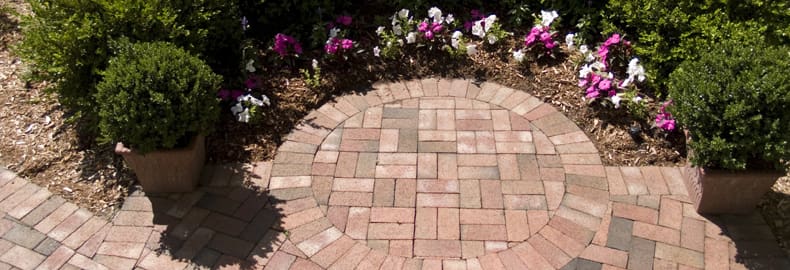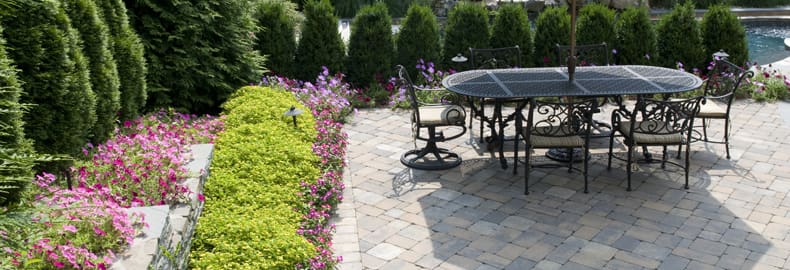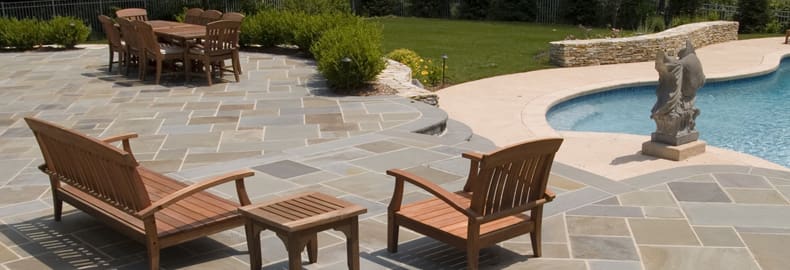Over the last few years, outdoor patios have become popular home features due to a trend toward outdoor living spaces. They add long-term value to your home and create additional space for entertaining. If you’re considering a new patio for your northern New Jersey home, do some research and gather outdoor patio installation tips to help you with proper planning.
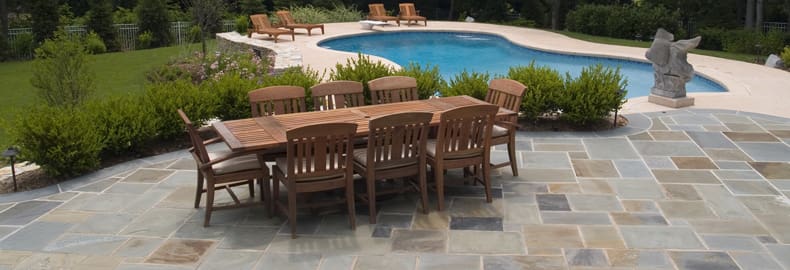
1. Choose Your Location
Most homeowners choose to locate an outdoor patio adjacent to the house, but a more remote location in the back yard can work as well. If you plan to use your patio for dining, keeping it close to the house will be more convenient for serving food and clean-up. You won’t have to walk as far and you can use your kitchen for cooking and refrigeration needs. On the other hand, a remote location can provide a private retreat for your patio. By installing an outdoor kitchen, you can cook and dine without using your indoor kitchen. In addition to a great grill, an outdoor kitchen can include a refrigerator, sink, storage drawers and cabinets, a dishwasher, wine cooler and beer kegerator. With these features, your outdoor kitchen will be self-sufficient, but it will require utility lines for gas, electricity and water.
Once you’ve chosen your ideal location, consider your area’s climate and weather conditions throughout the year. Buy some string and stakes and mark off the perimeter for your new patio, then monitor the area for a week or so.
- Observe the amount of sun and shade the area gets throughout the day
- Watch for debris or falling leaves from nearby trees and shrubs
- Watch for standing water or excessive moisture
Your location should offer both sun and shade throughout the day without excessive heat or darkness. Falling debris will give you a good idea of maintenance needs. Avoid low spots in the yard which can create standing water when it rains. Standing water and excessive moisture beneath the patio can cause mildew and weed growth. By following these outdoor patio installation tips, you can make sure you’ve chosen the best location.
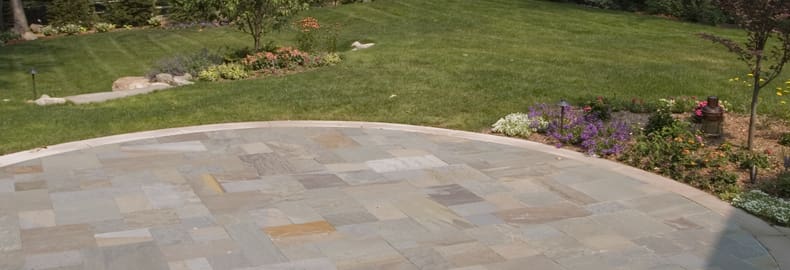
2. Consider Your Budget
Set a realistic budget for your new outdoor patio. Be aware that your budget will be impacted by the size of your patio, additional design features, materials you choose, landscaping and exterior lighting.
- Size – Your patio should be large enough to accommodate your needs. If you plan to use your patio for outdoor dining, provide adequate space for a dining table and chairs and additional casual seating.
- Design Features – If you want to include additional features like an outdoor kitchen, spa or hot tub, outdoor fireplace or fire pit, fountain or pond make sure you provide enough space to situate them in a convenient and comfortable spot.
- Materials – The materials you choose will impact your budget. Natural stones like granite, marble, travertine, limestone and slate are the most expensive. Mid-range choices include brick, flagstone and river rock. Concrete, aggregates and pea gravel are the least expensive.
- Landscaping – You need landscaping to add depth and dimension to your patio. Depending on the size of your back yard, you can choose from a variety of trees, shrubs, potted plants and flowers that will add beauty and atmosphere to your patio.
- Lighting – A functional outdoor patio needs adequate lighting. Whether you’re dining with friends or relaxing with family, you can’t use your patio at night without proper lighting. You can include landscape lighting for soft ambiance and patio lighting for function.
3. Choose Your Materials
There’s a variety of beautiful materials to choose from. For the best outdoor patio installation tips, consider durability, ease of maintenance and costs when choosing your materials.
- Natural Stone – Natural stone is the most popular choice for homeowners, but also the most expensive. The beauty of natural stone provides a natural look in any landscape. It’s durable and easy to maintain. Pavers are available in granite, marble, limestone, travertine and slate in a variety of sizes, shapes, colors and finishes. Natural stone is porous and should be sealed once or twice a year to prevent stains.
- Brick – Brick creates a classic, timeless look with traditional appeal and mid-range costs. It’s available in full size bricks that require mortar, as well as thinner brick pavers. It’s durable and easy to clean. Colors include red and muted shades of green, rust, brown, tan and beige. Brick pavers come in various sizes and finishes that resemble old and new bricks. Although brick is somewhat porous, a sealer isn’t always necessary for outdoor use.
- Rock – Flagstone and river rock are great for a mid-range budget. They create a natural, casual look and work well for casual and rustic landscapes. They are durable and easy to clean. Colors are natural shades of brown, gray and tan.They wear well outdoors without a sealer, but you can seal them for added stain protection. Use a matte finish sealer to retain a natural look.
- Aggregate Stones – Crushed stone, pea stone and other aggregate stones create a very casual look. As loose stones, they are very inexpensive and easy to install. For a more formal or tailored look, create a border with natural stone pavers or landscaping.
- Concrete – Concrete offers a durable, resilient and cost-effective choice for outdoor patios. It’s durable and easy to clean with soapy water and a hose. Concrete is a popular choice for outdoor patios due to new decorative options like stamped patterns and textures that mimic other materials. Concrete patios can be poured or set with individual pavers. Concrete comes in over 30 pre-mixed colors and 15 stains. Use a sealer for best stain protection.
4. Provide Shelter
It’s important to provide adequate shelter from sun, rain, cold, wind and snow. If your patio location gets a lot of sun throughout the day, consider adding a permanent roof structure or retractable awing or canopy. If that’s not possible, add patio umbrellas for shade. For added warmth and comfort on chilly evenings, install patio heaters, an outdoor fireplace or a fire pit. Bergen County, NJ weather can be unpredictable, especially during fall and winter months. By providing proper shelter, your new patio will be much more comfortable and functional year-round.
5. Hire a Landscape Contractor
For the best outdoor patio installation tips, hire a professional contractor. Although installing an outdoor patio can be a reasonable DIY project, hiring a professional contractor will eliminate potential problems and ensure the best long-term results. An outdoor patio requires proper preparation work that may include excavation and land grading. This work requires special equipment and should be done by a professional contractor. Prep work will create dust, noise and debris that will require clean-up and haul away equipment.
You may have utility lines for gas, electricity, water and sewer buried in your back yard. You don’t want to hit one while you’re doing prep work or build your new patio over them. Without knowing where your utility lines are located, you could be forced to dig up your patio for utility line repairs. A professional landscape contractor can check for utility lines and advise you on the best location for your new patio.

